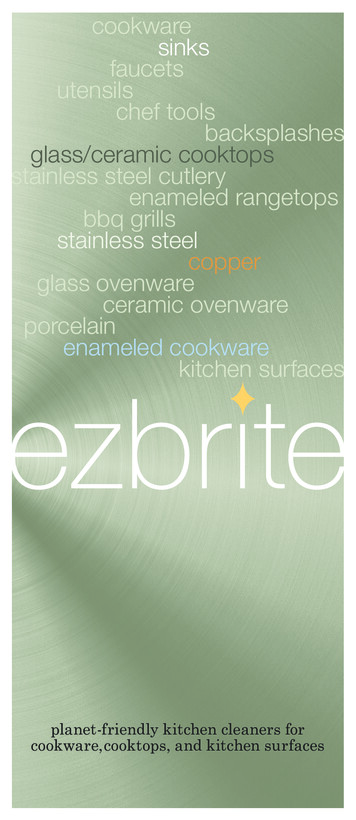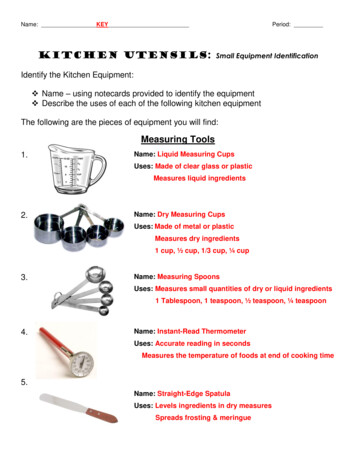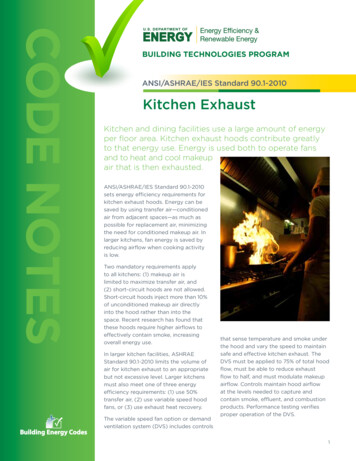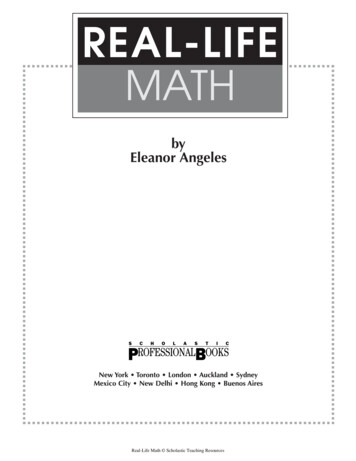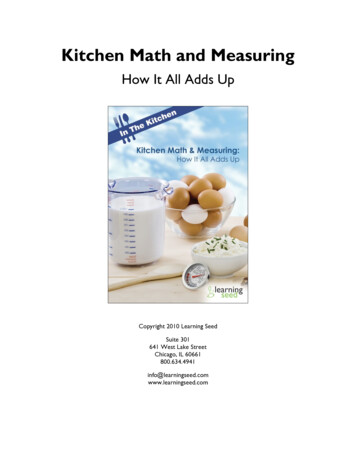
Transcription
Kitchen Math and MeasuringHow It All Adds UpCopyright 2010 Learning SeedSuite 301641 West Lake StreetChicago, IL seed.com
Kitchen Math and MeasuringHow It All Adds UpLegal NicetiesThe VideoCopyright 2010 Learning Seed.This video program is protected under U.S. copyright law. No part of this video may be reproduced or transmitted by anymeans, electronic or mechanical, without the written permission of the Publisher, except where permitted by law.Teaching GuideCopyright 2010 Learning Seed.This teaching guide is copyrighted according to the terms of the Creative Commons non-commercial 2.5/).It may be reproduced, in its part or its entirety, for classroom use. No part of this guide may be reproduced for sale by anyparty.You are free: to copy, distribute, display, and perform the work.to make derivative works.Under the following conditions: Attribution. You must attribute the work to Learning Seed.Noncommercial. You may not use this work for commercial purposes.For any reuse or distribution, you must make clear to others the license terms of this work.Any of these conditions can be waived if you get permission from the copyright holder.CreditsThe VideoThis Teaching GuideExecutive Producer: Kari Dean McCarthyWriter: Tracy UllmanProducer: Tracy Ullman/Kathleen O. RyanVideo Editor: Joanna BeerAssistant Producer: Jennifer A. SmithNarrator: Tom O’BrienCompilation: Jennifer A. SmithLearning Seed Catalog and ISBN NumbersQuestions or Comments?DVD LS-1241-10-DVDWe’d love to hear from you, whether you’d like a catalog,want to share your thoughts on one our titles, or have aquestion.Please contact us at:ISBN 1-55740-557-3Closed CaptioningThis program is closed-captioned.2Learning SeedSuite 301, 641 W. Lake StreetChicago, IL 60661800.634.4941info@learningseed.comKitchen Math and Measuring
SummaryExplore the world of measuring and math from the perspective of the chef. In this program, we notonly show you which tools to use, and how to use them, we also demonstrate how math can makeyour recipes do exactly what you need them to.We’ll step inside the kitchen to learn: Tools and methods used for measuring ingredients How and why we measure heat Equivalent measures for the U.S. and Metric systems How to double and halve recipesA recipe is designed to give the same results every time. You’ll know you’re reading a well-writtenrecipe when it includes:3 Measures of ingredients Number of servings Cooking Methods Measurement of heat Measurements of time Step-by-step instructionsKitchen Math and Measuring
Kitchen Tools for Measuring IngredientsMeasuring SpoonsStandard U.S. measuring spoons come in the following sizes: 1 tablespoon (tbsp) 15 milliliters (mL) 1 teaspoon (tsp) 5 milliliters (mL) 1/2 teaspoon (tsp) 2.5 milliliters (mL) 1/4 teaspoon (tsp) 1.25 milliliters (mL) 1/8 teaspoon (tsp) is about .5 milliliters (mL)In countries that use the metric system—that is, most countries other than the U.S., metric measuringspoons are the same size as US measuring spoons – they are just labeled a little differently. Metricspoons are measured in milliliters, or mL, as shown above.TIP: Don’t confuse tablespoons and teaspoons that measure, with the tablespoons and teaspoons inyour silverware drawer! Silverware sets are engineered for eating -- not accuracy.Measuring IngredientsMeasuring spoons measure both liquid and dry ingredients.Measuring Liquid Ingredients:When pouring a liquid, like vanilla extract, into a measuring spoon, hold the spoon level until the liquidreaches the brim.Fill the spoon over a sink, counter, or small bowl. If extra liquid spills over, you haven’t messed up yourrecipe.Measuring Dry Ingredients:For a dry ingredient, like baking powder, insert your spoon into the container and pull back against therim. That levels off the spoon to just the right amount.4Kitchen Math and Measuring
Measuring CupsDry IngredientsDry ingredients are often measured with nested measuring cups. These include: 1 cup (c) 8 ounces (oz) 250 milliliters (mL) 1/2 cup (c) 125 milliliters (mL) 1/3 cup (c) is about 75 milliliters (mL) 1/4 cup (c) is about 50 milliliters (mL)Measuring Dry IngredientsInstead of pouring ingredients into cups, use a scoop or a spoon to fill them, so the ingredient, likeflour, doesn’t get packed down.Fill the cup to the brim. Then level off any extra with a spatula.Sometimes a recipe may ask for something more specific than a cup. maybe a sifted cup.a heaping cup. or a packed cup. What does these mean?Sifting is a method of breaking up clumps and adding air to flour.One cup of sifted flour may weigh 5%-10% less than a cup of flour straight from the container.The result of using sifted flour is lighter cakes and pastries.Be sure to read the recipe carefully.If it says one cup flour, sifted, first measure the flour and level it off. Then use a sifter to sift itinto your mixing bowl. Measure first, sift second.If a recipe calls for one cup of sifted flour, first sift it into the measuring cup, and then level it off.To measure a heaping cup, pile the ingredient into the measuring cup, but don’t level it off. Justpour it directly into your mixing bowl.For light packing, use a clean hand or a spoon to lightly press the ingredient into the measuring cup.This removes air pockets to provide a more accurate measure. Lightly packed cups are used withbulky ingredients, like breadcrumbs.For firm packing, push down on the ingredient until you can’t fit anymore in the cup. Then level it off.5Kitchen Math and Measuring
Liquid IngredientsGraduated cups are used to measure liquid ingredients. These come in sizes as small as one or twocups, and usually go all the way to a quart -- the equivalent of four cups.Measuring cups for liquids are usually made of plastic or glass so you can align the liquid inside with themeasurements printed on the outside. Measurements are in cups, ounces, liters and fractions of thoseamounts.Liquid measuring cups are also a bit larger than the amount they‘re meant to measure, so you canmove the cup without spilling the liquid. There’s also a spout for easy pouring.Measuring Liquid IngredientsWhen measuring liquids, get down to eye level so you can see the graduated scale printed on the side.The liquid clings to the side of the cup and has a dip in the middle called the meniscus. The meniscus isthe curved upper surface of liquid in a container.To be exact, you should measure liquids in a graduated cup from the bottom of the meniscus.TIP: Measuring Peanut Butter To measure ingredients that are neither dry nor liquid, like peanut butter, spray a little cookingoil on the inside of a nested measuring cup. Use a rubber spatula to scoop the peanut butter out of its container and into the cup. Pack down the peanut butter to remove any air pockets and level it off. Use a spatula to scoop the peanut butter into your mixing bowl, and watch how easily it slidesout.You can use the same technique for other ingredients like butter or shortening.Another way to measure solid fat, like shortening or butter, is through water displacement.Displacement is the volume of water pushed aside when an object is completely submersed in liquid. Inthis case, our object is shortening, a fat frequently used in baking.Water is used for displacing fats and oils because oil and water don’t mix.Even though shortening is a solid, use a liquid measuring cup when using the displacement method soyou can see inside and use the measurements printed on the outside.6Kitchen Math and Measuring
The displacement method requires some simple math:Say you want to measure a half cup of shortening. The first number is half cup. The second is theamount of water needed to allow the shortening to float. One cup should do it.A half cup plus one cup is a cup-and-a-half. That is the number to aim for when measuring this amountof shortening in water.Choose a measuring cup large enough for both the required amount of shortening and the water usedto displace it.To measure ½ cup of shortening by displacement: Start with 1 cup of water. Use a spatula to add shortening to the water. Keep adding shortening until the water level reaches the target measurement of 1 ½ cups.Measuring WeightScales measure the weight of food in ounces when using the U.S. standard system. For the metricsystem, scales measure grams. Scales allow more accuracy than measuring cups.Digital scales are more accurate than mechanical scales.7Kitchen Math and Measuring
Kitchen Tools for Measuring HeatEvery stove-top has a thermostat to regulate the amount of heat generated inside the oven.Thermostats usually measure up to a temperature of 500 F or 260 C.Cooking thermometers, also called meat thermometers, come in a manual dial, an oven-safe mercurymodel, or digital models. Most measure between 0 F and 250 F or between -18 C and 121 C.Beware of undercooked meat and egg dishes! If a food’s internal temperature is between 40 F and140 F or between 4 C and 60 C, it may contain harmful bacteria, like e-coli. This can result in foodpoisoning.When cooking meat, fish or chicken, remember that color and juiciness can only help determinedoneness: a cooking thermometer is the best guide.Rare135 F-140 F57 C-60 CMedium rare140 F-145 F60 C-63 CMedium150 F-160 F65 C-71 CWell-done165 F 74 C TIP: Insert the thermometer probe 2” into the meat, away from the bone.Bone heats up much faster than meat, so putting the probe too close to the bone could give a falsetemperature reading.Thermometers for deep-frying foods and candy makingFor deep-frying foods, an oil or deep-fry thermometer shows when fat reaches the right temperaturefor cooking -- between 325 F and 375 F or between 163 C and 190 C.Candy thermometers come in digital, dial or bulb models. Candy cooks at very high temperatures, sothe thermometer starts at 100 F or 38 C degrees and can go as high as 550 F or 288 C.8Kitchen Math and Measuring
Recipe MathBefore you touch a utensil, though, you need to wash your hands!To properly wash your hands: Use soap and hot waterWash your palms, the backs of your hands and between your fingersTwist your fingertips into your palm or use a brush to clean under your nailsDry your hands with a single-use paper towelTIP: Wash your hands for at least 20 seconds. One way to make sure you do this is to recite thealphabet or sing the Happy Birthday song.TIP: Sticks of butter make it quick and easy to measure butter when baking.One stick of butter is 4 oz. or ½ cup. Most sticks have tablespoon measurements on the wrapper.Sugar Cookie Recipe (makes 48 cookies)2 ¾ cups all-purpose flour1 teaspoon baking soda½ teaspoon baking powder1 ½ cups white sugar1 teaspoon vanilla extract1 cup softened butter1 eggCombine flour, baking soda and baking powder. In a separate bowl, cream sugar,vanilla extract, and butter. Add egg and mix, then add flour mixture.Preheat oven to 375 F or 191 C. Bake for 10 minutes.9Kitchen Math and Measuring
To double a recipe, multiply all ingredient measurements by two.Sugar Cookie Recipe (makes 96 cookies)5 ½ cups all-purpose flour2 teaspoon baking soda1 teaspoon baking powder3 cups white sugar2 teaspoons vanilla extract2 cups softened butter2 eggsCombine flour, baking soda and baking powder. In a separate bowl, cream sugar,vanilla extract, and butter. Add egg and mix, then add flour mixture.Preheat oven to 375 F or 191 C. Bake for 10 minutes.To halve a recipe, divide all ingredient measurements by two.Sugar Cookie Recipe (makes 24 cookies)1 ¼ 2 tbsp all-purpose flour½ teaspoon baking soda¼ teaspoon baking powder¾ cups white sugar½ teaspoon vanilla extract½ cup softened butter1 ½ eggsCombine flour, baking soda and baking powder. In a separate bowl, cream sugar,vanilla extract, and butter. Add egg and mix, then add flour mixture.Preheat oven to 375 F or 191 C. Bake for 10 minutes.Half of an egg?!TIP: Eggs yield 3 tablespoons of liquid - egg yolk and white beaten together.Break yolk with white. Measure the egg in tablespoons. Since we need ½ an egg for this recipe, weneed half of 3 tbsp, or 1 ½ tbsp.10Kitchen Math and Measuring
Kitchen Math and MeasuringMatching QuizMatch the words in the first column to the best available answer in the second column.These utensils come in 1 tbsp, 1 tsp, 1/2 tsp, 1/4 tsp and sometimes 1/8 tsp. 1) meniscusA method of breaking up clumps and adding air to flour.2) measuring cupsAn ingredient pushed into the measuring cup or spoon until no morewill fit, then leveled off.3) lightly packedThe amount of space that an object or substance occupies.4) measuringspoonsThese utensils come in 1 cup, 1/2 cup, 1/3 cup and 1/4 cup.5) displacementA tool used to measure the temperature of food.6) volumeA bulky ingredient, like breadcrumbs, lightly pressed into measuring cup or7) firmly packedspoon.The curved upper surface of liquid in a container.The volume of water pushed aside when an object is completely submersed9) heapingin liquid.A measurement of an ingredient that is not leveled off.118) sifting10) cookingthermometerKitchen Math and Measuring
Kitchen Math and MeasuringMatching Quiz4These utensils come in 1 tbsp, 1 tsp, 1/2 tsp, 1/4 tsp and sometimes 1/8 tsp.1) meniscus8A method of breaking up clumps and adding air to flour.2) measuringcups7An ingredient pushed into the measuring cup or spoon until no morewill fit, then leveled off.3) lightly packed6The amount of space that an object or substance occupies.4) measuringspoons2These utensils come in 1 cup, 1/2 cup, 1/3 cup and 1/4 cup.5) displacement10A tool used to measure the temperature of food.6) volume3A bulky ingredient, like breadcrumbs, lightly pressed into measuring cup orspoon.7) firmly packed1The curved upper surface of liquid in a container.8) sifting5The volume of water pushed aside when an object is completely submersedin liquid.9) heaping9A measurement of an ingredient that is not leveled off.1210) cookingthermometerKitchen Math and Measuring
Kitchen Math and MeasuringFill-in-the-Blank ExerciseSugar Cookie Recipe (makes 48 cookies)2 ¾ cups all-purpose flour1 teaspoon baking soda½ teaspoon baking powder1 ½ cups white sugar1 teaspoon vanilla extract1 cup softened butter1 eggCombine flour, baking soda and baking powder. In a separate bowl, cream sugar,vanilla extract, and butter. Add egg and mix, then add flour mixture.Preheat oven to 375 F or 191 C. Bake for 10 minutes.Fill in the blanks based on the recipe above.Sugar Cookie Recipe (makes cookies)all-purpose flourbaking soda1 teaspoon baking powderwhite sugar2 teaspoons vanilla extract2 cups softened buttereggsCombine flour, baking soda and baking powder. In a separate bowl, cream sugar,vanilla extract, and butter. Add egg and mix, then add flour mixture.Preheat oven to 375 F or 191 C. Bake for .13Kitchen Math and Measuring
Kitchen Math and MeasuringFill-in-the-Blank Exercise Answer KeySugar Cookie Recipe (makes 48 cookies)2 ¾ cups all-purpose flour1 teaspoon baking soda½ teaspoon baking powder1 ½ cups white sugar1 teaspoon vanilla extract1 cup softened butter1 eggCombine flour, baking soda and baking powder. In a separate bowl, cream sugar,vanilla extract, and butter. Add egg and mix, then add flour mixture.Preheat oven to 375 F or 191 C. Bake for 10 minutes.Fill in the blanks based on the recipe above.Sugar Cookie Recipe (makes 96 cookies)5 ½ cups all-purpose flour2 teaspoons baking soda1 teaspoon baking powder3 cups white sugar2 teaspoons vanilla extract2 cups softened butter2 eggsCombine flour, baking soda and baking powder. In a separate bowl, cream sugar,vanilla extract, and butter. Add egg and mix, then add flour mixture.Preheat oven to 375 F or 191 C. Bake for 10 minutes .14Kitchen Math and Measuring
Kitchen Math and MeasuringMultiple ChoiceCircle the best answer for each question.1. Liquid measurements should be measuredfrom the of the meniscus.a)b)c)d)topbottomsidedistance2. An egg yields .a)b)c)a)3 teaspoons1 ½ tablespoons3 tablespoons4 tablespoons3. Cooking thermometers, also called meatthermometers, come in a:a)b)c)d)manual dialoven-safe mercury modeldigital modelall of the above4. are more accurate than.a)b)c)d)Digital scales; mechanical scalesMechanical scales; digital scalesScales; measuring cupsA and C5. The volume of water pushed aside when anobject is completely submersed in liquid:a)b)c)d)15weightareadisplacementnone of the above6. To halve a recipe, measurementsby .a)b)c)d)multiple; 2divide; 2multiple; 4divide; 47. Measuring cups for liquids are usually madeof .a) metalb) plasticc) glassd) B and C8. Measuring cups come in 1 cup, 1/2 cup,and .a)b)c)d)1/3 cup; 1/4 cup1/3 cup; 1/5 cup1/4 cup; 1/5 cup1/4 cup; 1/8 cup9. is a method of breaking upclumps and adding air to flour.a)b)c)d)ShakingSiftingShiftingShelling10. When pouring a liquid, like vanilla extract,into a measuring spoon, fill the spoon over:a)b)c)d)the sinka small bowlyour mixing bowlA and BKitchen Math and Measuring
Kitchen Math and MeasuringMultiple Choice Answer Key1. Liquid measurements should be measuredfrom the of the meniscus.a)b)c)d)topbottomsidedistance2. An egg yields .a)b)c)d)3 teaspoons1 ½ tablespoons3 tablespoons4 tablespoons3. Cooking thermometers, also called meatthermometers, come in:a)b)c)d)manual dialoven-safe mercury modeldigital modelall of the above4. are more accurate than.a)b)c)d)Digital scales; mechanical scalesMechanical scales; digital scalesScales; measuring cupsA and C5. The volume of water pushed aside when anobject is completely submersed in liquid:a)b)c)d)16weightareadisplacementnone of the above6. To halve a recipe, measurementsby .a)b)c)d)multiple; 2divide; 2multiple; 4divide; 47. Measuring cups for liquids are usually madeof .a) metalb) plasticc) glassd) B and C8. Measuring cups come in 1 cup, 1/2 cup,and .a)b)c)d)1/3 cup; 1/4 cup1/3 cup; 1/5 cup1/4 cup; 1/5 cup1/4 cup; 1/8 cup9. is a method of breaking upclumps and adding air to flour.a)b)c)d)ShakingSiftingShiftingShelling10. Where should you not fill a spoon overwhen measuring a liquid, like vanilla extract?a)b)c)d)the sinka small bowlyour mixing bowlA and BKitchen Math and Measuring
Glossary of TermsCooking Thermometera tool used to measure the temperature of food.Displacementthe volume of water pushed aside when an object is completely submersed inliquid.Firmly Packedan ingredient pushed into the measuring cup or spoon until no more will fit, thenleveled off.Heapinga measurement of an ingredient that is not leveled off.Lightly Packeda bulky ingredient, like breadcrumbs, lightly pressed into measuring cup orspoon.Meniscusthe curved upper surface of liquid in a container. Measurements should be madefrom the bottom of the meniscus.Scalea machine used to measure the weight of food.Siftinga method of breaking up clumps and adding air to flour.Volumethe amount of space that an object or substance occupies.17Kitchen Math and Measuring
Sugar Cookie Recipe (makes 48 cookies) 2 ¾ cups all-purpose flour 1 teaspoon baking soda ½ teaspoon baking powder 1 ½ cups white sugar 1 teaspoon vanilla extract 1 cup softened butter 1 egg Combine flour, baking soda and baking powder. In a separate bowl, cream sugar, vanilla extr

